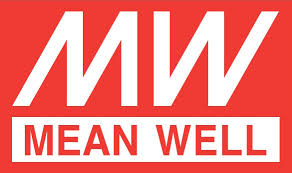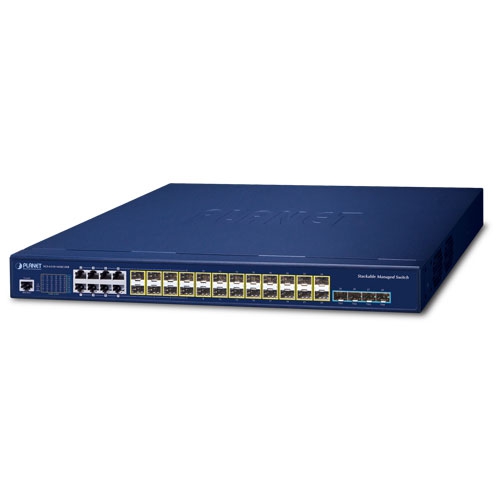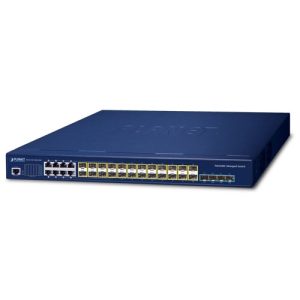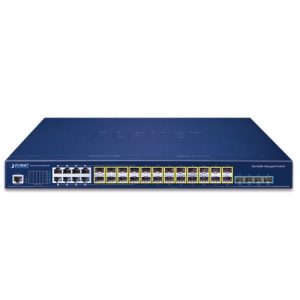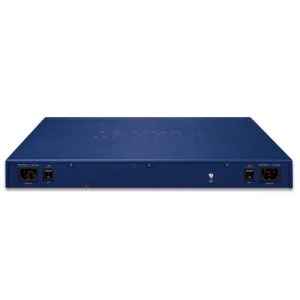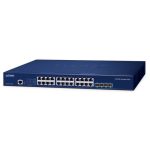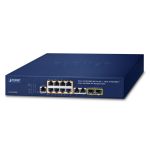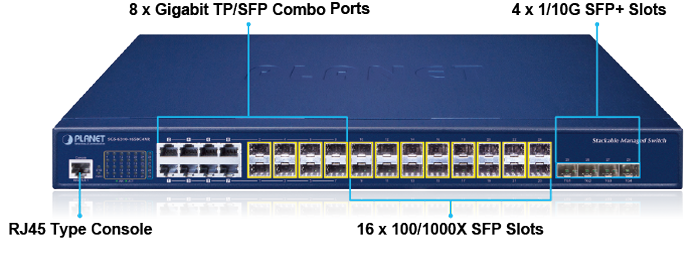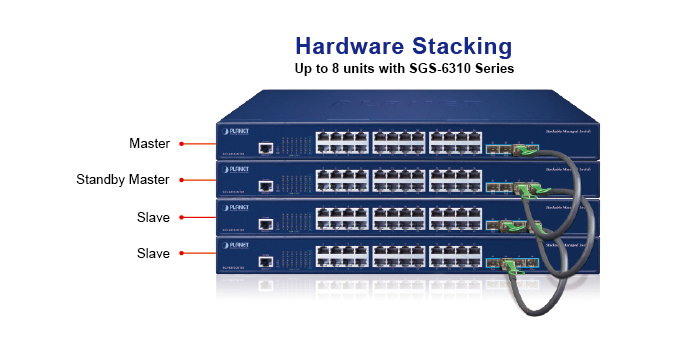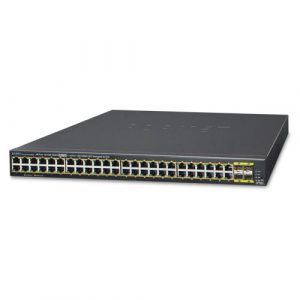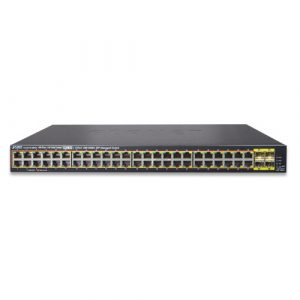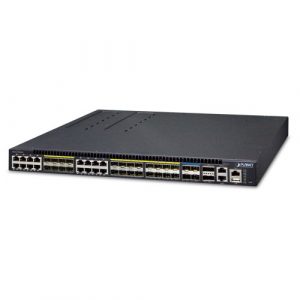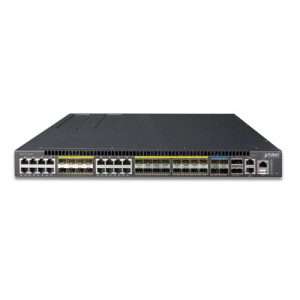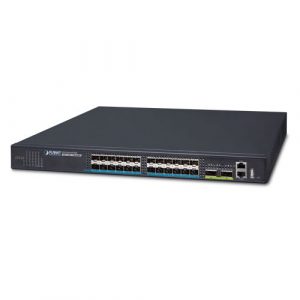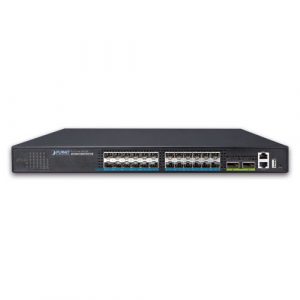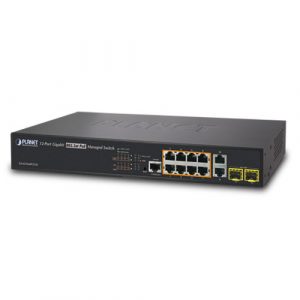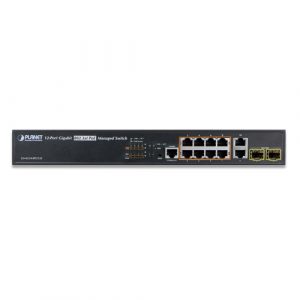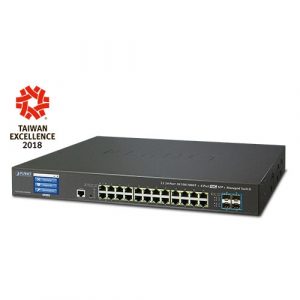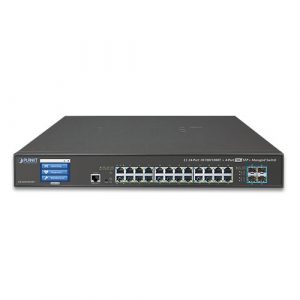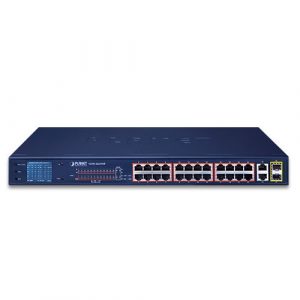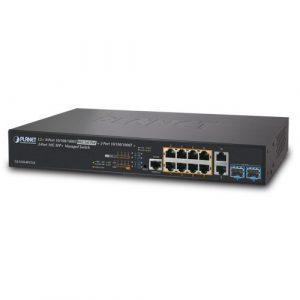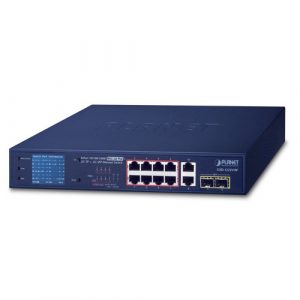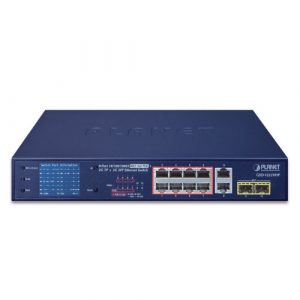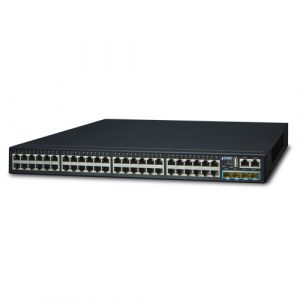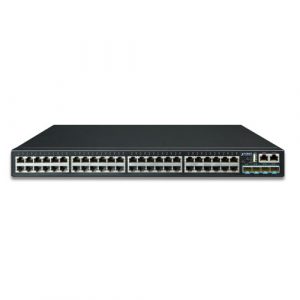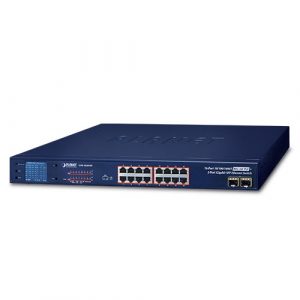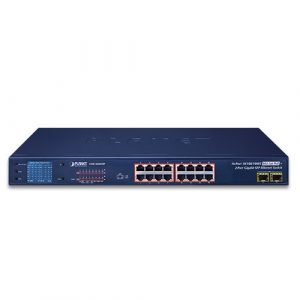SGS-6310-16S8C4XR
L3 16-Port 100/1000X SFP + 8-Port Gigabit TP/SFP + 4-Port 10G SFP+ Stackable Managed Switch (Dual 100~240V AC)
- Applicazioni
- SPECIFICHE
- DOWNLOAD
Descrizione
Soluzione di routing resiliente da 10 Gbps e Layer 3 per reti aziendali
La serie PLANET SGS-6310 è un nuovissimo switch Gigabit gestito impilabile Layer 3 con capacità di uplink da 10 Gbps per vari tipi di applicazioni di rete e implementazione flessibile. SGS-6310-16S8C4XR è dotato di 24 porte 100/1000BASE-X SFP e 8 porte 10/100/1000BASE-T RJ45 in rame, condivise con le porte da 1 a 8, e 4 porte 1G/10GBASE-X SFP+ con switch fabric da 128 Gbps fornite in un design robusto del case 1U.
La serie SGS-6310 fornisce prestazioni ad alta densità, routing statico IPv4/IPv6 Layer 3, funzionalità di routing dinamico RIP e OSPF, anello ERPS, abbondante motore di commutazione L2/L4 e tecnologia di stacking di switch virtuali per soddisfare l’esigenza di trasmissione pesante di tutti applicazioni. Offre alle aziende, ai fornitori di servizi e ai campus un controllo flessibile sulla densità delle porte, sugli uplink e sulle prestazioni dello stack di switch a un prezzo accessibile.
Capacità Ethernet da 10 Gbps ad alte prestazioni
Le quattro porte SFP+ integrate nella serie SGS-6310 vantano un’architettura di switch ad alte prestazioni in grado di fornire switch fabric non bloccante e throughput wire-speed fino a 80 Gbps, il che semplifica enormemente le attività di aggiornamento della LAN per soddisfare le crescenti richieste di larghezza di banda. Ciascuna delle porte SFP+ supporta Dual-Speed, 10GBASE-SR/LR o 1000BASE-SX/LX, il che significa che l’amministratore ora può scegliere in modo flessibile il ricetrasmettitore SFP/SFP+ adatto in base alla distanza di trasmissione o alla velocità di trasmissione richiesta per estendere la rete in modo efficiente .
Gestione centralizzata dello stacking hardware
Due delle porte SFP+ 10G possono essere configurate per connettere diverse serie SGS-6310 per creare una struttura virtualmente logica. La serie impilabile SGS-6310, adatta per aziende, fornitori di servizi e telecomunicazioni, offre un’elevata densità di porte, un’ampia larghezza di banda uplink e prestazioni elevate dello stack di switch, offrendo così grande flessibilità per diversi requisiti applicativi. La serie SGS-6310 può connettersi come un anello per la ridondanza e garantisce che l’integrità dei dati venga mantenuta anche in caso di guasto di uno switch nello stack. È anche possibile sostituire gli switch a caldo senza interrompere la rete, il che semplifica notevolmente le attività di aggiornamento della LAN per soddisfare le crescenti richieste di larghezza di banda.
Anello ridondante, ripristino rapido per applicazioni di rete critiche
La serie SGS-6310 supporta la tecnologia ad anello ridondante e presenta una capacità di ripristino automatico forte e rapida per prevenire interruzioni e intrusioni esterne. Incorpora la tecnologia avanzata ITU-T G.8032 ERPS (Ethernet Ring Protection Switching) e il protocollo Spanning Tree (802.1s MSTP) nella rete del cliente per migliorare l’affidabilità del sistema e il tempo di attività in ambienti difficili. In una determinata rete ad anello semplice, il tempo di ripristino potrebbe essere inferiore a 10 ms per riportare rapidamente la rete al normale funzionamento.
Supporto del routing di livello 3
La serie SGS-6310 consente all’amministratore di aumentare comodamente l’efficienza della rete configurando manualmente il routing statico Layer 3, automaticamente le impostazioni RIP (Routing Information Protocol) o OSPF (Open Shortest Path First).
- Il RIP può utilizzare il conteggio dei hop come metrica di routing e prevenire i loop di routing implementando un limite al numero di hop consentiti in un percorso dall’origine alla destinazione.
- L’OSPF è un protocollo di routing dinamico interno per sistemi autonomi basato sullo stato del collegamento. Il protocollo crea un database per lo stato dei collegamenti scambiando stati dei collegamenti tra gli switch di livello 3, quindi utilizza l’algoritmo Shortest Path First per generare una tabella di routing basata su quel database.
Robuste funzionalità di livello 2
La serie SGS-6310 può essere programmata per funzioni di gestione dello switch di base come configurazione della velocità delle porte, aggregazione delle porte, VLAN, protocollo Multiple Spanning Tree, controllo della larghezza di banda e snooping IGMP. Questo switch fornisce funzioni VLAN con tag 802.1Q, Q-in-Q, VLAN vocale e protocollo GVRP. Supportando l’aggregazione dei collegamenti delle porte, la serie SGS-6310 consente il funzionamento di un trunk ad alta velocità combinato con più porte. Abilita fino a 64 gruppi per il trunking con un massimo di 8 porte per ciascun gruppo.
Eccellente soluzione per la sicurezza aziendale e il passaggio QoS
La serie SGS-6310 esegue switch fabric non bloccanti da 128 Gigabit al secondo, quindi può facilmente fornire una rete Ethernet locale a larghezza di banda elevata da 10 Gbps per la dorsale del tuo dipartimento. Con le quattro porte SFP+ integrate, la serie SGS-6310 fornisce l’uplink alla rete backbone tramite i moduli 10G Ethernet LR/SR SFP+. Migliora ulteriormente l’efficienza della rete e protegge i client di rete offrendo funzionalità di sicurezza e QoS.
Routing VLAN di livello 3
Grazie ai robusti protocolli di routing del traffico Layer 3 integrati, la serie SGS-6310 garantisce un routing affidabile tra VLAN e segmenti di rete. I protocolli di routing possono essere applicati tramite l’interfaccia VLAN. La serie SGS-6310 è sicuramente una soluzione conveniente e ideale per le aziende.
| Hardware Specifications | |
|---|---|
| SFP/mini-GBIC Ports | 24 100/1000BASE-X SFP ports (ports 1 to 24) Compatible with 100BASE-FX SFP transceiver |
| Copper Ports | 8 10/100/1000BASE-T RJ45 auto-MDI/MDI-X ports, shared with Ports 1 to 8 |
| 10G SFP+ Ports | 4 10GBASE-SR/LR SFP+ ports (ports 25 to 28) Backward compatible with 1000BASE-SX/LX/BX SFP transceiver |
| Console Port | 1 x RJ45-to-RS232 serial port (9600, 8, N, 1) |
| DRAM | 256Mbytes |
| Flash Memory | 16Mbytes |
| Dimensions (W x D x H) | 440 x 280 x 44 mm |
| Weight | 4000g |
| Power Consumption | 38 watts/129.58BTU |
| Power Requirements- AC | AC: 100~240V, 50/60Hz |
| Fan | 2 |
| LED | System: SYS, PWR Green Ports: 10/100/1000T RJ45 Port: LNK/ACT Green 1/10G SFP+ Port: LNK/ACT Green |
| Switching Specifications | |
| Switch Architecture | Store-and-forward |
| Switch Fabric | 128Gbps/non-blocking |
| Switch Throughput | 95.23Mpps |
| Address Table | 16K MAC address table with auto learning function |
| ARP Table | 2K |
| Routing Table | 2040 |
| VLAN Interface | 64 |
| IP Interface | 64 |
| ACL Table | 1024 |
| Shared Data Buffer | 1.5MB |
| Jumbo Frame | 9KBytes |
| Flow Control | Back pressure for half duplex IEEE 802.3x pause frame for full duplex |
| IPv4 Layer 3 Functions | |
| IP Routing Protocol | Static route RIPv1/v2 OSPFv2 Policy-based routing (PBR) Hardware-based Layer 3 routing |
| Routing Features | VRRP v1/v3 ARP ARP Proxy IGMP Proxy |
| IPv6 Layer 3 Functions | |
| IP Routing Protocol | RIPng OSPFv3 IPv6 LPM Routing IPv6 Policy-based Routing (PBR) IPv6 VRRPv3 IPv6 RA(Router Advertisement) Hardware-based Layer 3 routing |
| Routing Features | Configured Tunnels GRE Tunnel ISATAP Tunnel,6 to 4 tunnel Manual tunnel |
| Other | ICMPv6, IPv6 ND |
| Layer 2 Functions | |
| Port Configuration | Port disable/enable Auto-negotiation 10/100/1000Mbps full and half duplex mode selection Flow control disable/enable Bandwidth control on each port Port loopback detect |
| Port Status | Display each port’s speed duplex mode, link status, flow control status and auto negotiation status |
| VLAN | 802.1Q tagged VLAN, up to 4K VLAN groups 802.1ad Q-in-Q (VLAN stacking) GVRP for VLAN management Private VLAN Edge (PVE) supported Protocol-based VLAN MAC-based VLAN IP subnet-based VLAN |
| Spanning Tree Protocol | STP, IEEE 802.1D (Classic Spanning Tree Protocol) RSTP, IEEE 802.1w (Rapid Spanning Tree Protocol) MSTP, IEEE 802.1s (Multiple Spanning Tree Protocol, spanning tree by VLAN) Supports BPDU and root guard |
| Multicast | IPv4 IGMP v1/v2/v3 snooping Querier mode support IPv6 MLD v1 snooping Multicast VLAN Register (MVR) Up to 1024 multicast groups (IPv4 + IPv6) |
| Link Aggregation | IEEE 802.3ad LACP/static trunk Supports 64 groups with 8 ports per trunk group |
| Bandwidth Control | TX/RX/Both At least 64Kbps step |
| QoS | 8 priority queues on all switch ports Supports strict priority and Weighted Round Robin (WRR) CoS policies Traffic classification: – CAR, HQoS, MAC/IP/TCP/UDP – IEEE 802.1p CoS/ToS – IPv4/IPv6 DSCP – Port-based WRR – Tail-Drop, WRED, flow monitoring and traffic shaping |
| Ring | Supports ITU-G G.8032 ERPS Recovery time < 10ms @ 3units Recovery time < 50ms @ 16units |
| Security Functions | |
| Access Control List | Supports Standard and Expanded ACL IP-based ACL/MAC-based ACL Time-based ACL Up to 1024 entries |
| Security | Port isolation, Port security, “IP+ MAC+ port” binding MAC sticky DAI & IP source guard, PPPoE+ L2/L3/L4 ACL flow identification Filtration Anti-attack from DDoS, TCP’s SYN Flood, UDP Flood Broadcast / multicast / unknown unicast storm-control Supports MD5, SHA-256, RSA-1024, AES256 |
| AAA Authentication | TACACS+ and IPv4/IPv6 over RADIUS |
| Network Access Control | IEEE 802.1x port-based network access control MAC-based authentication RADIUS/TACACS authentication |
| Switch Management Functions | |
| System Configuration | Console and Telnet Web browser SNMP v1, v2c |
| Secure Management Interfaces | SSHv1/v2, TLSv1.2 and SNMPv3 |
| System Management | Supports both IPv4 and Ipv6 addressing Supports the user IP security inspection for Ipv4/Ipv6 SNMP Supports MIB and TRAP Supports RMON 1, 2, 3, 9 (four groups) Supports Ipv4/Ipv6 FTP/TFTP Supports Ipv4/Ipv6 NTP Supports the RADIUS authentication for Ipv4/Ipv6 Telnet user name and password The right configuration for users to adopt RADIUS server’s shell management Supports Security IP safety net management function: avoid unlawful landing at non-restrictive area Supports Ipv4 and Ipv6 DHCP server |
| SNMP MIBs | RFC 1213 MIB-II RFC 1215 Internet Engineering Task Force RFC 1271 RMON RFC 1354 IP-Forwarding MIB RFC 1493 Bridge MIB RFC 1643 Ether-like MIB RFC 1907 SNMP v2 RFC 2011 IP/ICMP MIB RFC 2012 TCP MIB RFC 2013 UDP MIB RFC 2096 IP forward MIB RFC 2233 if MIB RFC 2452 TCP6 MIB RFC 2454 UDP6 MIB RFC 2465 IPv6 MIB RFC 2466 ICMP6 MIB RFC 2573 SNMP v3 notify RFC 2574 SNMP v3 vacm RFC 2674 Bridge MIB Extensions (IEEE 802.1Q MIB) RFC 2674 Bridge MIB Extensions (IEEE 802.1P MIB) |
| Event Management | Supports Syslog server for Ipv4 and Ipv6 |
| Hardware Stacking | 8 members max. 2 10G SFP+ slots are functioned as Stacking Up and Down interfaces |
| Hardware Stacking Compatibility List | SGS-6310-24T4X SGS-6310-24P4X SGS-6310-16S8C4XR |
| SNMP MIBs | RFC 1213 MIB-II RFC 1215 Internet Engineering Task Force RFC 1271 RMON RFC 1354 IP-Forwarding MIB RFC 1493 Bridge MIB RFC 1643 Ether-like MIB RFC 1907 SNMP v2 RFC 2011 IP/ICMP MIB RFC 2012 TCP MIB RFC 2013 UDP MIB RFC 2096 IP forward MIB RFC 2233 if MIB RFC 2452 TCP6 MIB RFC 2454 UDP6 MIB RFC 2465 IPv6 MIB RFC 2466 ICMP6 MIB RFC 2573 SNMP v3 notify RFC 2574 SNMP v3 vacm RFC 2674 Bridge MIB Extensions (IEEE 802.1Q MIB) RFC 2674 Bridge MIB Extensions (IEEE 802.1P MIB) |
| Standard Conformance | |
| Regulatory Compliance | FCC Part 15 Class A, CE |
| Standards Compliance | IEEE 802.3 10BASE-T IEEE 802.3u 100BASE-TX IEEE 802.3z Gigabit 1000BASE-SX/LX IEEE 802.3ab Gigabit 1000BASE-T IEEE 802.3ae 10Gb/s Ethernet IEEE 802.3x flow control and back pressure IEEE 802.3ad port trunk with LACP IEEE 802.1D Spanning Tree Protocol IEEE 802.1w Rapid Spanning Tree Protocol IEEE 802.1s Multiple Spanning Tree Protocol IEEE 802.1p Class of Service IEEE 802.1Q VLAN tagging IEEE 802.1ad Q-in-Q VLAN stacking/tunneling IEEE 802.1x port authentication network control IEEE 802.1ab LLDP RFC 768 UDP RFC 783 TFTP RFC 791 IP RFC 792 ICMP RFC 2068 HTTP RFC 1112 IGMP v1 RFC 2236 IGMP v2 RFC 3376 IGMP v3 RFC 2710 MLD v1 RFC 2328 OSPF v2 RFC 1058 RIP v1 RFC 2453 RIP v2 ITU-T G.8032 ERPS Ring |
| Environment | |
| Operating | Temperature: 0 ~ 50 degrees C Relative Humidity: 10 ~ 90% (non-condensing) |
| Storage | Temperature: -20 ~ 70 degrees C Relative Humidity: 5 ~ 95% (non-condensing) |



